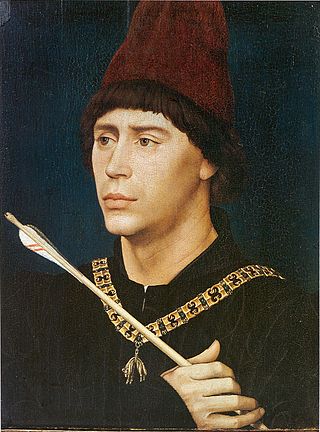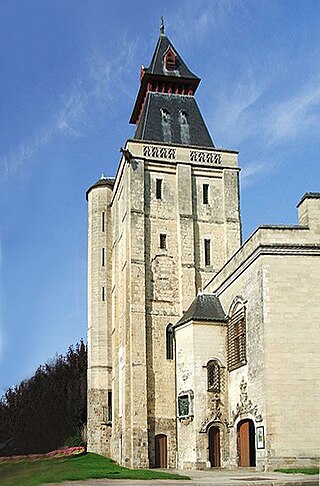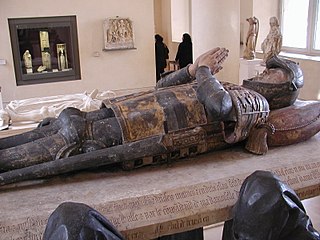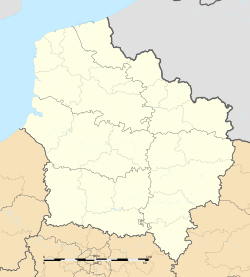
Philip II the Bold was Duke of Burgundy and jure uxoris Count of Flanders, Artois and Burgundy. He was the fourth and youngest son of King John II of France and Bonne of Luxembourg.

Picardy is a historical and cultural territory and a former administrative region located in northern France. The first mentions of this province date back to the Middle Ages: it gained its first official recognition in the 13th century through the nation of Picardy at the University of Paris and entered French administration in the 14th century. Unlike regions such as Normandy, Brittany, or Champagne, Picardy was never established as a duchy, county, or principality, and its boundaries fluctuated over the centuries due to the political instability in the area it covered. Since 1 January 2016, it has been part of the new region of Hauts-de-France.

Charles Martin, called the Bold, was the last duke of Burgundy from the House of Valois-Burgundy, ruling from 1467 to 1477. He was the only legitimate son of Philip the Good and his third wife, Isabella of Portugal. As heir and as ruler, Charles vied for power and influence with rivals such as his overlord, King Louis XI of France. In 1465 Charles led a successful revolt of Louis's vassals in the War of the Public Weal.
Duke of Burgundy was a title used by the rulers of the Duchy of Burgundy, from its establishment in 843 to its annexation by the French crown in 1477, and later by members of the House of Habsburg, including Holy Roman Emperors and kings of Spain, who claimed Burgundy proper and ruled the Burgundian Netherlands.

The Duchy of Burgundy emerged in the 9th century as one of the successors of the ancient Kingdom of the Burgundians, which after its conquest in 532 had formed a constituent part of the Frankish Empire. Upon the 9th-century partitions, the French remnants of the Burgundian kingdom were reduced to a ducal rank by King Robert II of France in 1004. Robert II's son and heir, King Henry I of France, inherited the duchy but ceded it to his younger brother Robert in 1032.

John I was a scion of the French royal family who ruled the Burgundian State from 1404 until his assassination in 1419. He played a key role in French national affairs during the early 15th century, particularly in his struggle to remove the mentally ill King Charles VI and during the Hundred Years' War against Kingdom of England. A rash, ruthless and unscrupulous politician, John murdered Charles's brother, the Duke of Orléans, in an attempt to gain control of the government, which led to the eruption of the Armagnac–Burgundian Civil War in France and in turn culminated in his own assassination in 1419.

The Burgundian Wars (1474–1477) were a conflict between the Burgundian State and the Old Swiss Confederacy and its allies. Open war broke out in 1474, and the Duke of Burgundy, Charles the Bold, was defeated three times on the battlefield in the following years and was killed at the Battle of Nancy in 1477. The Duchy of Burgundy and several other Burgundian lands then became part of France, and the Burgundian Netherlands and Franche-Comté were inherited by Charles's daughter, Mary of Burgundy, and eventually passed to the House of Habsburg upon her death because of her marriage to Maximilian I, Holy Roman Emperor.

The Burgundian Netherlands were those parts of the Low Countries ruled by the Dukes of Burgundy during the Burgundian Age between 1384 and 1482. Within their Burgundian State, which itself belonged partly to the Holy Roman Empire and partly to the Kingdom of France, the dukes united these lowlands into a political union that went beyond a personal union as it gained central institutions for the first time.

The Treaty of Arras was signed at Arras on 23 December 1482 by King Louis XI of France and Archduke Maximilian I of Habsburg as heir of the Burgundian Netherlands in the course of the Burgundian succession crisis.

Doullens is a commune in the Somme department, Hauts-de-France, France.

The Congress of Arras was a diplomatic congregation established at Arras in the summer of 1435 during the Hundred Years' War, between representatives of England, France and Burgundy. It was the first negotiation since the Treaty of Troyes and replaced the fifteen-year agreement between Burgundy and England that would have seen the dynasty of Henry V inherit the French crown. Historian Richard Vaughan has called it "Europe's first real peace congress."

John II of Luxembourg, Count of Ligny was a French nobleman and soldier, a younger son of John of Luxembourg, Lord of Beauvoir, and Marguerite of Enghien. His older brother Peter received his mother's fiefs, including the County of Brienne, while John received Beaurevoir. He married Jeanne de Béthune, Viscountess of Meaux, widow of Robert of Bar, on 23 November 1418, and became step-father to Jeanne de Bar, Countess of Marle and Soissons. He and Jeanne de Béthune had no children.

Antoine de Bourgogne, known to his contemporaries as the Bastard of Burgundy or Le grand bâtard, was the natural son of Philip III, Duke of Burgundy, and one of his mistresses, Jeanne de Presle. He was comte de La Roche (Ardenne), de Grandpré, de Sainte-Menehould et de Guînes, seigneur de Crèvecoeur, Beveren et Tournehem, and chevalier of the Golden Fleece.

Margaret of Nevers, also known as Margaret of Burgundy, was Dauphine of France and Duchess of Guyenne as the daughter-in-law of King Charles VI of France. A pawn in the dynastic struggles between her family and in-laws during the Hundred Years' War, Margaret was regarded as the future Queen of France at two separate times, as a result of her two marriages: first to the Dauphin and second to the Duke of Brittany.

The House of Valois-Burgundy, or the Younger House of Burgundy, was a noble French family deriving from the royal House of Valois. The Valois-Burgundy family ruled the Duchy of Burgundy from 1363 to 1482 and eventually came to rule vast lands including Artois, Flanders, Luxembourg, Hainault, the county palatine of Burgundy (Franche-Comté), and other lands through marriage, forming what is now known as the Burgundian State.

Abbeville is a commune in the Somme department and in Hauts-de-France region in northern France.

Philippe Pot (1428–1493) was a Burgundian nobleman, military leader, and diplomat. He was the seigneur of La Roche and Thorey-sur-Ouche, a Knight of the Golden Fleece, and the Grand Seneschal of Burgundy.

The Siege of Oudenaarde took place in 1452. It was one of the major engagements in the Revolt of Ghent (1449–53). The city was besieged by forces of the rebellious city of Ghent and defended by forces led by Simon de Lalaing, one of the leading captains of Philip the Good, Duke of Burgundy. The siege included one of the largest artillery bombardments then seen in Europe. The relief of the town by forces under Philip and his allies opened the way for an attack on Ghent by the Burgundian forces. In 1453 the rebels were defeated at the Battle of Gavere.

The Burgundian State was a polity ruled by the Dukes of Burgundy from the late 14th to the late 15th centuries, and which ultimately comprised not only the Duchy and County of Burgundy but also the Burgundian Netherlands. The latter, acquired piecemeal over time and largely through inheritance, was, in fact, their principal source of wealth and prestige. The Dukes were members of the House of Valois-Burgundy, a cadet branch of the French royal House of Valois, and the complex of territories they ruled is sometimes referred to as Valois Burgundy. The term "Burgundian State" was coined by historians and was not in contemporary use; the polity remained a collection of separate duchies and counties in personal union under the Duke of Burgundy.



















